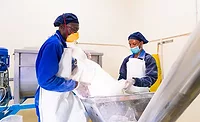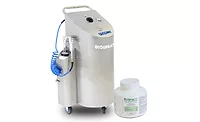Maximizing Sanitation Efforts in Food Processing

Hygienic standards in food-processing operations continue to rise with each passing year, and they have never been higher than they are today. Not only is it essential to have proper procedures and equipment for cleaning in place, but installing such products as conveyor belting and components that are designed to facilitate efficient sanitation are critical in successfully maintaining superior standards of hygiene.
Eliminating Factors of Contamination
Contamination can occur when a belt experiences wear and, as a result, begins to crack and fray, shedding small pieces into the product being conveyed. This poses a grave health hazard as well as a threat of recall action, especially in raw product-contact applications. Traditional flat belts are made up of multiple layers of material, creating a safety issue as fabric inner layers can retain moisture, eventually cracking and fraying because of differential stresses in the layers. Unfortunately, the only remedy is a complicated welding and/or vulcanizing process, often requiring compressed air and water.
The creation of Intralox ThermoDrive® belting was meant to overcome the health hazards posed by this phenomenon. Made from a single homogeneous thermoplastic material that does not crack or fray, its design eliminates food contamination risks. This belting features a non-porous surface, meaning there is no risk of food product fluid leaking through the belt and, therefore, no chance of bacterial growth. Belt repairs are easy, using a simple splicing device that requires only electricity. Lastly, because it employs a sprocket-driven, low-tension system, mistracking problems and the need for a tensioning device become worries of the past.
Selecting Belts that Fit Your Needs
It is essential to select belting solutions specifically designed for your products and applications. When striving to comply with the high standards of sanitation, conveyor belt material is an important factor to consider. The non-absorbent, non-porous material of modular plastic belting is ideal for food conveyance.
Modular plastic belting is assembled in an interlocked, bricklayed pattern with full-length hinge rods—an inherently strong design. This is especially useful with heavier loads or in high-impact applications as its modular design allows for more weight on the belt’s surface while maintaining the ability to complete tight transfers. Despite its robust design, modular plastic is still lighter than alternative belting materials, easing installs or repairs. The modular design allows for pieces to be removed or added when needed without the need for welding. Production efficiency is maintained as these repairs can be made without removing the belt from the conveyor.
Forging Partnerships to Achieve Food Safety
The benefits of modular plastic with features designed to deliver improved sanitation results are offered by Intralox SeamFree™ belting. When used in sanitation-critical applications, it has been proven to deliver savings in water consumption and related energy costs, as well as in cleaning time and labor.
Japan’s largest meat dealer has adopted this specific belting for several of their processing plants. They spent over a year reviewing and analyzing their hardware and software, identifying necessary improvements to attain SQF 2000 (Safe Quality Food) certification. In an effort to expand and upgrade their facilities, they decided to install this type of belting. Since installation, plant officials have noted that during daily sanitation, the water drains off the belting very well, leaving no noticeable dirt.
The Next Step in Sanitation: Automated Belt Cleaning
Extensive studies of different plants led Intralox to develop and tailor the EZ Clean family of components to meet specific sanitation challenges faced by food manufacturers. Traditional in-line sprockets engage in the same area of the belt’s underside as they rotate, making certain portions of the belt inaccessible for cleaning. The Angled EZ Clean Sprockets are designed so that the sprocket teeth engage different portions of the belt as they rotate, allowing for cleaning access to 100% of the belt’s underside.
Intralox’s Clean In Place (CIP) system was designed to defeat the inconsistent and time-consuming nature of manual belt cleaning. The CIP system provides an automated, cost-efficient and thorough sanitation practice and is specifically engineered to optimally clean belts and sprockets.
Continual Innovation
As hygienic standards become more stringent, food processors should strive to stay ahead of the trend by adopting the most effective products to combat contamination. Intralox has a full-time team of dedicated specialists that stay on top of the latest food safety regulations and continually test products in both the lab and the field to discover the most effective cleaning practices.
www.intralox.com
Looking for quick answers on food safety topics?
Try Ask FSM, our new smart AI search tool.
Ask FSM →








